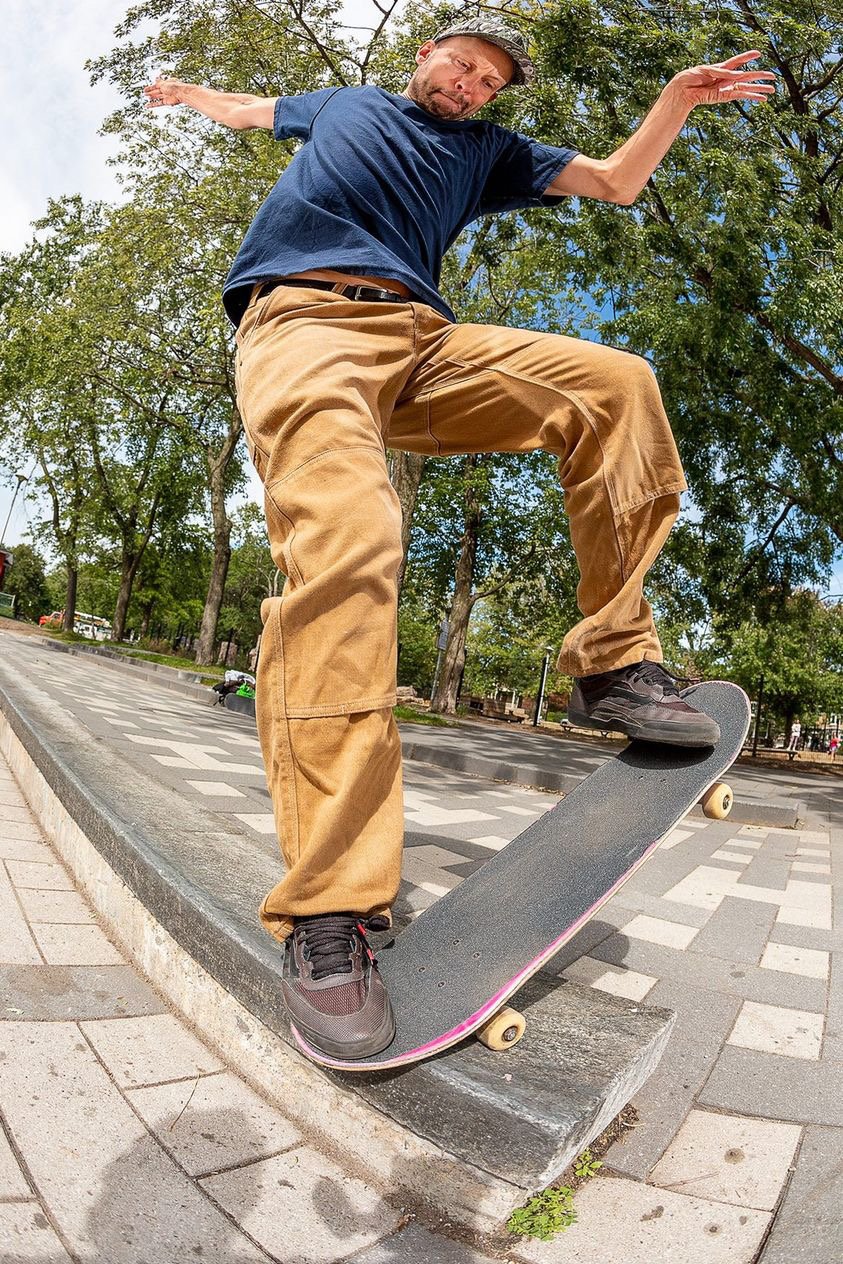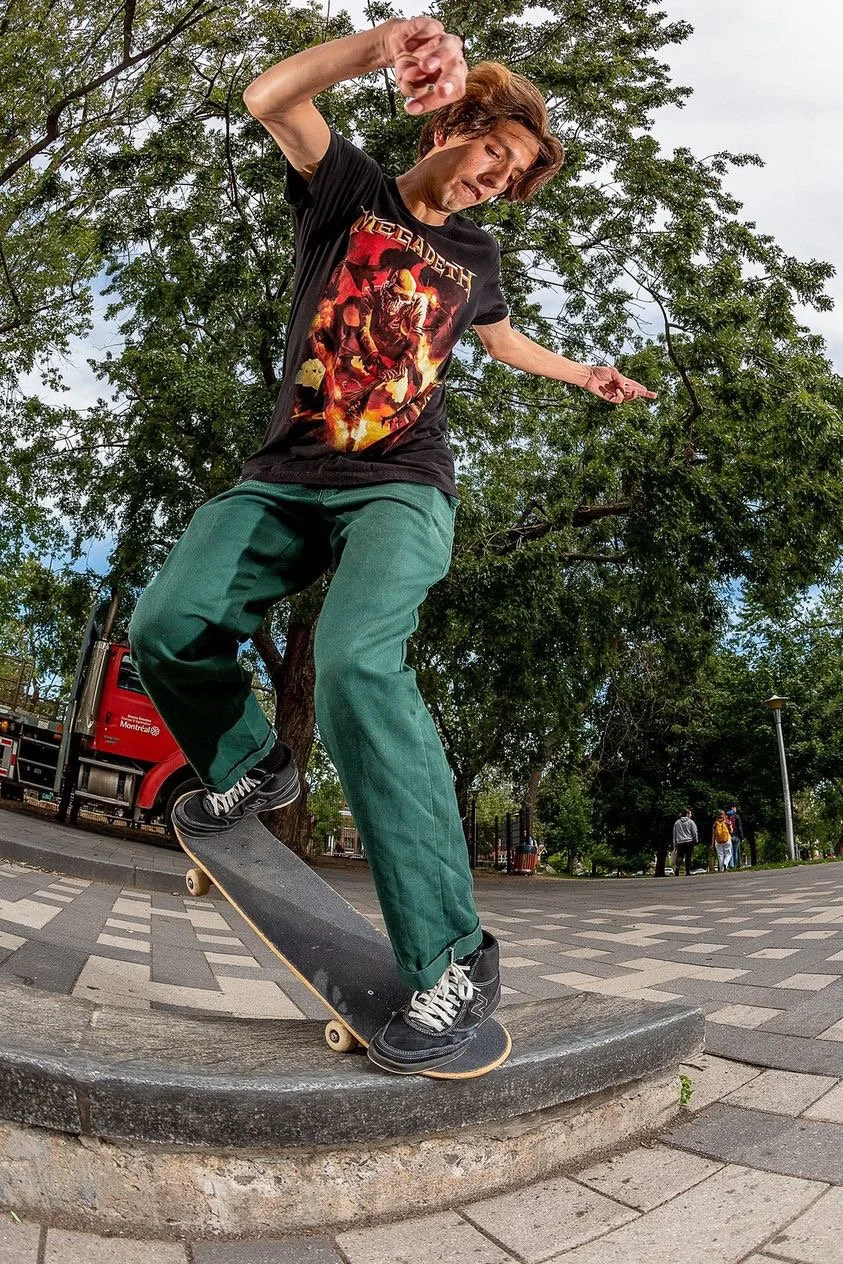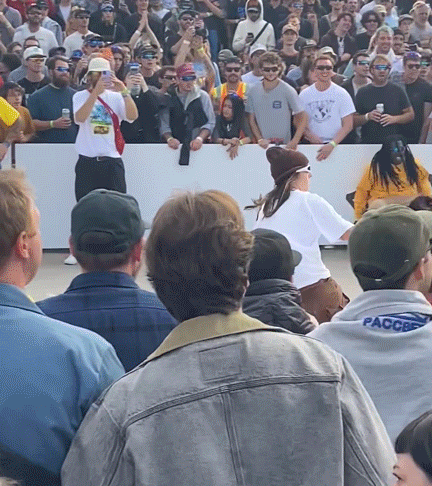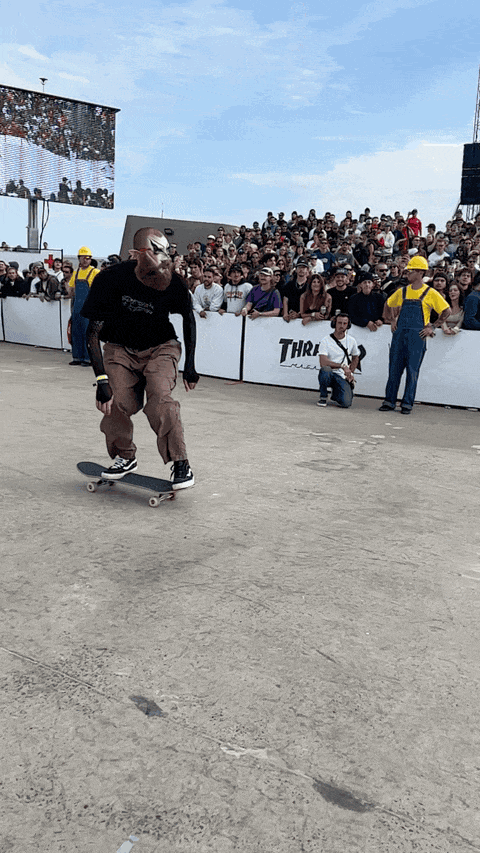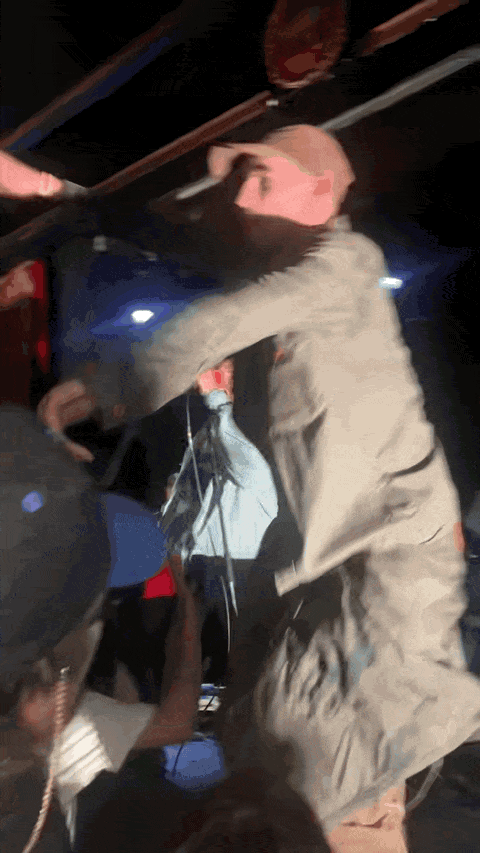Dime Piece
This week we’re blessed to have Sam Korman of Waxing The Curb providing his detailed (and heartwarming!) recollection of the recent VP expedition to Montreal for the Dime Glory Challenge.
Day 1: Smoked Meat
Headed through the Adirondacks on the way to glory.
The plan was to meet everyone in Montreal. My publisher, Have-you-heard-that-podcast and I would drive a comically long Toyota Pathfinder. Our friends, the filmer, Padfinder, Twitter star, Young Mathi, and my other publisher, At-home-by-twelve had driven up the day before. Two more, filmmaker, Kid Criterion and industry insider, Back-home-in-Arizona, would follow that afternoon. We would share an Airbnb. The writer, At-work-on-my-novel and his colleague, Tiny Dancer had booked plane tickets. The placemaking at our minimally appointed loft included inspirational quotes. “Be awesome today,” read the one by the door.
The ride up was miraculously smooth (we left before weekend traffic), and, perhaps owing to pleasant driving conditions, my new friend, Have-you-heard-that-podcast and I were already divulging our family histories before we had even left Queens. We talked about our parents. About the Rust Belt. He had just had a kid. “I love her, and for me, it’s really interesting to think what horrible, unethical corner of the Internet she would need to find to disappoint me. Doesn’t seem possible.” Have-you-heard-that-podcast’s mindset marries a skater’s curiosity with design logic, and it’s fascinating to hear him apply his talent for user flows to the vicissitudes of life. It wasn’t long, though, before our conversation turned to skate gossip. Relatively green to the skate media landscape, I naively asked about this and that recent controversy. Why did ———— go out of business? How is ———— unsponsored? As I might have guessed from our conversations, Have-you-heard-that-podcast had answers, and we chatted about the latest beefs all the way to Montreal.
When we arrived, we regrouped with everyone else and headed out for food. It was Have-you-heard-that-podcast’s birthday, and we tracked down one of Montreal’s gifts to the world: a Jewish delicacy simply called smoked meat. It was, in many ways, how our weekend began. Not with hitting the road. Not with skating. Not with the first sight of a pro skater. Not even with my first White Claw. Nor my second. Nor my third. No, it was with a smoked meat sandwich from Schwartz’s Deli that we marked our arrival.
The source of smoked meat and a glimpse at Padfinder.
Meat that has been smoked.
At first, we sat around a picnic table, silently wolfing down our sandwiches. The meat was succulent, the portion sensible. A would-be great sandwich had it not been for the mustard. The meat cutters had categorically refused to provide more. At first, I worried, because I had suggested the place, and the first night often sets the tone for the trip. But then I remembered that skaters are naturally contrarian. “Hey, sorry, I’m going to go out of my way to help you figure out where that spot is,” Padfinder had said earlier that night, mocking Canadian hospitality in what I called “kindness burns”. “Also, here’s the keys to my car, the code to my apartment, and 20 bucks. You can borrow them for the weekend, eh.” And so, it was with this circle of beautifully inconsequential trash talk that my weekend truly began.
Day 2: Sufganiyot
By the second day, I began to feel as if my life had come full circle. Skate writing was new to me. At the onset of lockdown, I had abandoned a career as an art critic, and decided to try my hand in an even less remunerative role as a skate writer (ok, skate blogger). Starting something new, writing about something so central to my identity, but which I had not yet put to words was both thrilling and painful. I felt exposed—as in youth, a poser once more. But I also felt unified for the first time in ages. Perhaps testifying to the fit of my new path, or, perhaps, the onerous nature of art criticism, people stopped crossing the street when they saw me (true story), and I was able, as a straight white guy in my mid-30s, to escape the tendency to withdraw (see SNL skit “Man Park”), coming out of the pandemic with more friends, not less. (As a Buffalonian, a skate trip to Canada also caused deja vu).
A podcast enthusiast sans headphones. Bluntslide. Photo by Ted Schmitz.
A young executioner of a time-tested trick. Backside noseblunt. Photo by Ted Schmitz.
Polish doughnuts, sold to us in French.
In any case, my high expectations soon caved in. We were there as spectators, but also to skate, electing to hit a ledge spot before the Dime Glory Challenge that afternoon. But having forgone breakfast, I grumpily admonished myself as everyone else got clips. Young Mathi contorted himself into a backside noseblunt. Padfinder steered himself uphill and down curbs for a circuitous, multi-tiered manual. At-home-by-twelve, having lived up to his name the night before, energetically pounced onto the ledge for a backtail shove-it (a weekly ritual for him). And then there was Back-home-in-Arizona. He was truly in his element when surrounded by skaters, the presence of old friends acting on him like some kind of rejuvenating, beatific drug. Skating with incredible fluidity and a sense of wholeness, he racked up an astronomical trick count, accenting each one with all manner of spontaneous flourish, dervish-like rotations, whirlybirds, and 270 shove-its. He also does this unusual thing, and critiques his own skating, sometimes mid-trick, though in the midst of peers, his criticisms sound more like funny homilies to the saints. “Wouldn’t count in Fisheye’s book, would it?” He might say to himself, referring to an old photographer friend. By the time his display came to a close, Back-home-in-Arizona regarded the rest of us with an imperturbable expression, his eyes narrowed as if basking in the sun.
And there I was, unable to grasp how anyone could turn their shoulders before lunch. I was saved, however, by a nearby Polish deli, where I bought a dozen sufganiyot for the crew—what a local we skated with referred to as “blesséd donuts.” One bite of the delicately fried pastry yielded a black hole of prune paste that pulled your tastebuds into the depth of its flavor. Two bites later, I wedged myself into a tailslide, and we were back in Kid Criterion’s car, on our way to the Dime Glory Challenge.
Contest, nontest, mock Olympics—the Dime Glory Challenge does not fall easily into a single category. It resembles a WWE wrestling event more than anything, and even that’s not quite right. Framed as a series of challenges, the event satirizes institutional attempts to frame skateboarding as a sport. The Speed Challenge shirks style points, and clocks flatground tricks with a speedometer. The Rainbow Challenge, which stacks a series of arch-shaped rails to higher and longer proportions, seems more like a track and field event. And the Art Show Challenge parodied a self-serious art auction. Of course, this year would once again name the World Champion of Skate, mounting a grudge match between Alexis Sablone and Breanna Geering. And finally, there was the Volcano Challenge, the DGC’s flame throwing, foam spitting, finale.
Is this church? No, it’s a tribute to Joe.
But in ways I had not realized before attending the event myself, the DGC is also deeply local, representing a sort of regional circus sideshow, complete with all sorts of unusual characters. Dime was one of the first digital native skate brands to excel in the social media landscape (remember, Instagram only came out in 2010). Taking to these platforms, they spoke the lingua franca of the internet—irony. And they spoke it loud, parodying the bro-y-ness of contemporary skate culture, while also building an idiosyncratic mythology for themselves. The jokes, too, were hilariously culty and insular, combing skateboarding’s awkward past with an unabashedly French Canadian perspective. Their heroes weren’t Mike Carroll or Gino Iannucci, they were unglamourous outsiders like meathead Rob “Sluggo” Boyce, local lionheart, Alexis Lacroix, and lumberjack Ryan Decenzo, for whom the DJ had a special button that echoed his name throughout the stadium anytime he landed a trick. The Dime Glory Challenge itself seems designed to insert Montreal locals into a line up of biggest legends and pros.
Sipping a Black Cherry Bud Light Seltzer (yeah, it was going to be a hard seltzer weekend) I took in the event from the VIP section. We were late, and the skating had already begun, but the first thing to catch my attention was not Crazy Frankie’s high speed hippie jump or Felipe Nunes’ kickflip into the Euro gap. Rather, I was struck with the presence of social media managers on their phones. The most privileged access went to people dressed like catalog models for the brands they represent, and who could be distinguished by the leash that led from their phone to the power bank in their backpack. Lui Elliot, Thrasher’s social guy, made a spectacle of himself, as he trailed the skaters down the ramps, but mostly, these digital field mice scampered along the edges, scurrying this way and that with each passing run. Of course, this was a nontest. It would have no definitive, climactic moment. No comically large checks would be handed out, either. But this, to me, seemed prime to generate content. Pratfalls and slapstick, goofiness and conflict were as relevant as tricks in this context, which refused the decisive hierarchies of a winning run or best trick. Indeed, the quid quo pro was that VIPs might get a little extra breathing room to get a better angle, and post their contribution. Because, aren’t we all friends?
Youppi was grooving all day.
No cynicism lasts for long, though, as the announcers summarily stirred me from my initial apprehensions. They were some of my favorite participants in the Dime Glory Challenge. More merry prankster than hypemen, they bellowed into the mic, riling up the crowd with calls of “Montreal!” Their voices breathed excitement, with one raspy-throated announcer adding some jolly mayhem. “I sound like if Oscar the Grouch and Hulk Hogan had a baby,” he said. “And it was raised by Macho Man Randy Savage.”
Indeed, the underlying parody of the whole affair created a permissive atmosphere, which different pros interpreted in different ways. Faded legend, Eric Koston could always be seen with a beer, and seemed as relevant alongside the younger crowd as Youppi, the Montreal Canadian’s goofy mascot, who was also in attendance. At the same time, Evan Smith stood in the middle of the course for a full two minutes, showing something on his phone to no one in particular (it was weird). Obviously, there was no code of conduct, but recently-minted pro, Nicole Hause seemed to take up the party spirit better than most. Behind a silver pair of raver shades, she copped a stoney, laissez-faire attitude, playing comic foil to the seriousness of other skaters. Smacking her head, before tackling the fourth tier of the rainbow rail, minor head trauma was but one sign that she had committed to the bit, and was serious about having fun.
Mason Silva’s contest appearance, though, was perhaps the best example of a skater embracing the Dime Glory Challenge’s minor ego death. After a groin injury waylaid his afternoon, I watched the 2020 Skater of the Year high five a young fan as if the kid were his peer. Sparks flew the from latter’s braces, and, speaking to the Quebecer afterwards, I heard about a new skater enthralled by pros whose names he did not yet know. What made the moment extra special, however, was that Silva wore the same palpable excitement on his face, too. The DGC is a parody of a contest. But it is also a parody of skateboarding as a form of labor. With their faces locked behind a stoic expression, men dressed in matching, Minions-like uniforms (Dime + Minions = Dimions?) make light of hard work, holding up stop signs and clearing debris with a leaf blower. Against this quasi-satirical backdrop (afterall, the Dimions did actually build the ramps), Silva’s efforts could frame him like an A-student who always wants to get it right (as they sometimes do). But rather than be a try-hard, he charmingly redirected his nervous energy into a supporting role during the game of skate, becoming Breezy’s grimacing bodyguard.
The best we could do digging up evidence of the broken bleacher.
My friends were scattered throughout the arena. Some were in the normal seating area. My publishers were with me in VIP, assiduously documenting the event. The crowd bounced on the wooden bleachers to a hyperpop version of Cher’s “Believe”. With one challenge remaining, I decided to speak to the crowd (afterall, I was a foreign correspondent), mounting the stands as massive fireballs exploded from the top of a Volcano-shaped quarterpipe. “It’s like the WWE,” a young couple from the UK told me. Not skaters themselves, these vacationers had simply wandered into the Dime Glory Challenge. Another skater I spoke to had made the 12-hour drive from Halifax to be here. Clearly enthusiastic, his highlights from the day surprised me. “The DJs,” he said, bobbing his head. Silently, he scratched himself under his mesh top until he looked at me suspiciously and walked away.
My most meaningful conversation would prove to be with a group of 19 year-old women. In the past, the DGC could not be accused of gender diversity, but this year’s edition included a significantly more diverse group of pros, many of whom these women had come to see. “I cried when I saw Nora Vasconcellos,” one of them told me, clutching her skateboard to her chest. “It’s true,” seconded her friend. “Her hotel is next to my flat, and I couldn’t even speak when I asked for an autograph,” the first skater continued. As she told me this story, she choked up. “Before I saw Nora,” she added, “I didn’t know it was possible to do this.”
Perhaps the most glorious moment of the Challenge. Nicole Hause, 50-50,
Chandler Burton, nollie backside 180 in full elf makeup.
When day one of the Dime Glory Challenge ended, I hung around with my friends near the exit. “I’m still buzzing,” said Kid Criterion with excitement. “There is just so much to process.” I insinuated myself into a circle that included the friendliest (but also most opinionated) guy in skateboarding, Back-home-in-Arizona. He’s the most social person I know, and once more, I found him in his element, wearing that beatific smile as he greeted this and that friend. Everything is framed as a hypothetical when he talks, as if the excitement he feels is so great, he can only grasp it rhetorically. “Oh, was that the absolute most fun thing you have ever seen since you first learned how to kickflip?” He might ask. “Um, would you happen to be referring to none other than the people’s champ, Nicole Hause?” Even spicy opinions—like, say, who has fake style—which he shares liberally, betray a sense of obsessive care, and are frequently accompanied with some self-deprecation. “As someone who has dished it for years,” he has said. “I know I am on the chopping block. I am prepared to take it.” Yet, while he is an industry insider, all pros are met with the same reverence he has for his friends back home, a personal ethic that cultivates immediate familiarity, and which gets even the shyest or more hardened skaters to let their guard down. A circle had formed around him, and it was there that I met my social media idol, Arin, who looked out from behind her curls, and gave me an uncannily delicate fistbump.
Obviously, no winner was named that day. Though as we swirled about in a kind of professional vortex, the skaters being herded onto a shuttle bus, and the rest of us trying to figure out what to do for dinner, I wondered what the stakes had been for the pros in coming here. It wasn’t simply to skate, was it? Careers also depended on a certain number of public appearances and reposts, no? Right then, as if to answer my question, Chandler Burton passed me. They had skated (and did the gnarliest tricks of the Dime Glory Challenge) in their drag persona, Bottom Feeder, a moth-like nymph with iridescent features; baroque, symmetrical facial patterning; a bushy beard; and pointy ear prosthetics. Their trick selection was captivating, too, inserting campiness into the contest with a garish dolphin flip and a nollie 360 that turned ever-so-satisfyingly the wrong way. Contributing banger after banger, and even breaking their board on a nollie backside 180 off the two-story bump to bar, their presence all weekend offered a reminder that, skateboarding, at bottom, turns the whole world into a stage.
Day 3: Matzoh Ball Soup
Sometimes on a trip, you need to take a little space for yourself. And on Sunday, as I recovered from White Claws and a few misguided tequila shots, I took it slow. The rest of the crew skated the old part of town before the afternoon rain. I took a walk with At-work-on-my-novel, and we talked about skate writing (er, blogging). We walked through Chinatown and passed Peace Park where one of that afternoon’s events would be held, though Dime eventually canceled it.
This is what poutine looks like.
As we walked, we caught up about recent projects, and speculated about skate culture’s reach beyond its insular world. Taking a wistful tone, At-work-on-my-novel described to me an upcoming performance he is developing with one of our favorite pros, and his collaborator, Tiny Dancer. His description reminded me of the Belgian artist Marcel Broodthaers in that moment, another writer turned artist who questioned systems of value. “Finally the idea of inventing something insincere crossed my mind and I set to work straightaway,” Broodthaers had once said. Speaking with At-work-on-my-novel, I wondered if he was about to embark on a similar project in the skate world, and I could see how the buffoonery of the DGC fit into it. “I’ve decided not to write about skate-related events I’m attending,” he confessed. “I am just not interested in that kind of writing anymore.” The weather, no longer an intermittent drizzle, had begun to pour. And so, I made a solo pilgrimage to Deli Snowdon for matzoh ball soup (poutine and a Diet Coke).
By the time I arrived at the Hill Challenge, the steady downpour threatened a washout. The Hill Challenge’s centerpiece was a modular flat bar, which was meant to extend down the hill, but few skaters felt called to skate it, even in its truncated form. Adding to the somber mood was a lack of commentary. On my way in, I had seen the announcers fumbling with a megaphone, but they apparently never got it to work. In their absence, the long pauses to squeegee the takeoff ramp not only slowed down the action, but left the crowd awash in silence. Ollies were soggy. And even the sound of skate wheels on the wet pavement, ordinarily a head-turner, were muted. Watching the pros trek back up the hill also felt particularly unfair. Alongside long rows of attendees, cozy under their rain jackets and umbrellas, Crazy Frankie cut a sad image, resembling a wet cat whose ordinarily fluffy fur now revealed the scrawny frame beneath. Determined to put on a show, though, he smiled, as he had the entire weekend (honestly, I just love him).
Pedro Delfino paying homage, no matter how risky, no matter how soggy.
Still, skating has a long history with rain, and that afternoon, I was reminded how some of its most mythical tricks were done when the sky came down. Pedro Delfino 50-50’d the flat bar first try, a trick that barely registered against the collective struggle everyone else seemed to have. Mostly, competitors eschewed the flat bar, and chucked flip tricks off the platform at the top instead. Hill bombs ensued. Hometown hero Léon Chapdelaine even added some theatrics by turning switch half way down Avenue Hotel-de-Ville. Generally, though, caution prevailed, as everyone who made it to the bottom of the hill faced the same danger: the following intersection lacked a spotter.
For my part, I wasn’t sure how long I would last in the rain. The other members of the skate media cut more diehard images. Ponchos cloaked the numerous photographers as if they had just stepped off the Maid of the Mist (Buffalo reference). Plastic deli bags were tied around video cameras. Never one to miss a session, Back-home-in-Arizona weathered both a hangover and the rain beneath a one-man tent. He’s not a drinker, but the night before, he had joined in, downing many White Claws (and, betraying his inexperience with drinking by closing the night with a few sugary aperol spritzes). Still, I saw the same smile I had seen the night before, though it appeared a little sleepier. Comparatively, I snapped a few shots with my Kodak disposable from the bottom of the hill before the lens fogged up. Sunday’s event simply lacked the trappings of the day before, but fortified by my friends’ resolve, we stuck it out, and witnessed a long pair of struggles two other skaters put in with their tricks. As he so often does, Alexis Lacroix bucked convention, and slid the rail with his shoes, before acid dropping onto his board. Rowan Zorilla, though, would make something more sincere out of conditions that had come to seem like an outlandish joke.
If you’re reading this, you have by now seen the trick already. Perhaps you saw Chromeball’s video angle. Or Closer Magazine’s. Or Thrasher’s. Mike Heikkila’s photo was perhaps the best, the crowd closing in behind Rowan as he crouched into a z-like position toward the end of the flat bar, the long, steep hill stretching out before him. The result of more than 20 tries, even bailing had been treacherous, each time forcing him to slide several meters on the soles of his shoes. One time, he sacked himself.
To be honest, in person, I did not know if Rowan would land it. Watching from the bottom of the hill, I had grown distracted. Young Mathi took a Facetime call from a pair of girlfriends in New York who wanted to hang out. “What is up my queens?” He greeted them, before letting them down easy. The call was so posi, tender. He really was not one to carouse, as when, later that night, twitter betrayed his disinterest in a group of young women that were at his side. Instead, he had tweeted a pun: “Damn crazy I’m just realizing that Santa sleighs”. It was when he hung up, though, that we both saw Rowan lean himself onto the long yellow rail for what would prove to be the one, watching as he barely held on, hydroplaning a full 30 feet upon landing. “I’m so glad I hung up when I did,” declared Young Mathi, clearly pleased with himself for catching the trick without having to impolitely drop the call. We milled about for a few more moments, before the relentless rain finally drove us home.
Did they have mosh pits in Arizona? Apparently they did.
Epilogue: A Weird Wrap in Vermont
Montreal had been fun. The drive back to New York, less so. The rain would not abate until we were an hour outside of New York, and so, Have-you-heard-that-podcast and I white-knuckled it through a downpour. We hydroplaned like Rowan, but it was not as fun.
Detoured via Vermont, Have-you-heard-that-podcast kept a steady hand on our rental car. Conditions worsened. Needing something to dispel my anxiety (and to get my mind off the weird chicken caesar wrap I ate for lunch), I proposed a game, the premise of which was to envision a skate-adjacent brand—name, product, sponsored skaters, etc. To my surprise, my publisher clearly had a few in the chamber. A y———— company. A s————— company. He had the strategy laid out. D———, J————, and J———— would skate for him. It would have a lot of New York clout. My answer: “Elf hats?”
The rain ensured a steady buzz of emotion the whole way back. At one point, I saw a video of Back-home-in-Arizona crowd surfing on Instagram. The closing festivities had included a few hardcore bands, and, clearly, he went for it one last night. The video showed him stage dive, and I laughed, watching him float across a sea of friends (and friends of friends). He was elated (in that punk sort of way). My mind drifted elsewhere, distracted by a slip of the tires. As we got closer to New York, and the weekend was approaching its end, I thought back to a conversation I had had with Kid Criterion on the first night. “I just needed to be a skater again,” he confided on our way back to the Airbnb. Some early success in the f———— industry had led to burnout. But even in adulthood, skating offered an alternative to the pressure to perform, and the precarity of creative careers. I sympathized. Skateboarding had also drawn me back in with its open endedness (and friends). I took an Uber home from the rental car
company. I was grateful to be a skater again.





